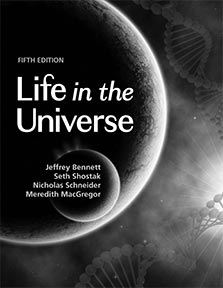 Buy Direct Buy on Amazon
Buy Direct Buy on AmazonAll this world is heavy with the promise of greater things, and a day will come, one day in the unending succession of days, when beings, beings who are now latent in our thoughts and hidden in our loins, shall stand upon this earth as one stands upon a footstool, and shall laugh and reach their hands amidst the stars. –H. G. Wells, 1902
Praise for Life in the Universe
“This textbook combines the explosion in our knowledge of life on Earth with the latest findings about solar system environments, extrasolar planets, and SETI. It is the right text at the right time for teaching some of the fastest-moving topics in science.” — Chris Chyba, Carl Sagan Chair for the Study of Life in the Universe, SETI Institute, and Stanford University
“A thoughtful and well-written tour through the emerging field of astrobiology. Many university educators will want to use this book.” — Professor James Kasting, Penn State University
“… well-written, very interesting, and covers very well the broad sweep of sciences included in astrobiology.” — Stacy Palen, University of Washington
“Very well written and accessible… one of the best expositions of the subject I have ever seen. The end-of-chapter questions are extensive, thought provoking, and pitched at just the right level.” — Sukanta Bose, Washington State University
“… the level of reading is excellent throughout… the material is very easy to follow. The authors know their stuff and explain it very well. Unlike many textbooks nowadays, it’s well written and thought provoking…” — Juan Cabanela, Haverford College
“… very readable and compelling. Key topics are explained in such a way that my non-scientist students will really understand them.” — David Thomas, Lyon College
“… asks lots of good questions throughout the text… should encourage the student to really think about this exciting subject.” — Harold Geller, George Mason University
“The finest text on the subject I have ever encountered… it should become a classic.” — Wayne Anderson, Sacramento City College
Life in the Universe
Few questions have so inspired humans through the ages as the mystery of whether we are alone in the universe. Many ancient Greek philosophers were confident that intelligent beings could be found far beyond Earth. When the first telescopes were trained on the Moon in the seventeenth century, some eminent astronomers interpreted lunar features as proof of an inhabited world. A little over a century ago, belief in a civilization on Mars became so widespread that the term martian became synonymous with alien. But despite this historical interest in the possibility of extraterrestrial life, until quite recently few scientists devoted much effort to understanding the issues surrounding it, let alone to making a serious search for life.
In the past few decades, however, a remarkable convergence of biology, geology, astronomy, and other sciences has suddenly placed the issue of extraterrestrial life at the forefront of research. Advances in our understanding of the origin of life on Earth are helping us predict the conditions under which life might arise in other places. Discoveries of microbes thriving under extreme conditions (at least by human standards) on Earth have raised hopes that life might survive even in some of the harsh environments found elsewhere in our own solar system. Proof that planets exist around other stars—first obtained in the 1990s—has given added impetus to the study of the conditions that might allow for life in other star systems. Technological advances are making it possible for us to engage in unprecedented, large-scale scrutiny of the sky for signals from other civilizations, spurring heightened interest in the search for extraterrestrial intelligence (SETI). Perhaps most important, scientists have found the interdisciplinary study of issues related to the search for life beyond Earth to have intrinsic value, independent of whether the search is ultimately successful.
Given the intense research efforts being undertaken by the scientific community and the long-standing public fascination with the search for life, it should be no surprise that the study of life in the universe—also known as astrobiology—has become one of the most publicly visible sciences. Colleges, too, have recognized the growing importance of this discipline, and many have begun to institute astrobiology courses. This book aims to serve such courses by offering a comprehensive introduction to the broad science of life in the universe.
Although this is a textbook, it is designed to be of interest to anyone with a desire to learn about the current state of research in astrobiology. No special scientific training or background is assumed, and all necessary scientific concepts are reviewed as they arise. If you have a basic high school education and a willingness to learn, you are capable of understanding every topic covered in this book.
Table of Contents
PART I INTRODUCING ASTROBIOLOGY
1. A Universe of Life?
2. The Science of Life in the Universe
3. The Universal Context of Life
PART II LIFE ON EARTH
4. The Habitability of Earth
5. The Nature of Life on Earth
6. The Origin and Evolution of Life on Earth
PART III LIFE IN THE SOLAR SYSTEM
7. Searching for Life in Our Solar System
8. Mars
9. Life on Jovian Moons
10. The Nature and Evolution of Habitability
PART IV LIFE AMONG THE STARS
11. Extrasolar Planets: Their Nature and Potential Habitability
12. The Search for Extraterrestrial Intelligence
13. Interstellar Travel and the Fermi Paradox
Epilogue: Contact–Implications for the Search and Discovery
